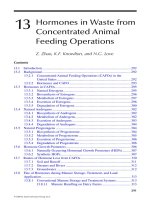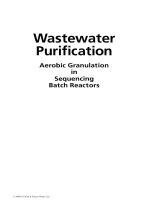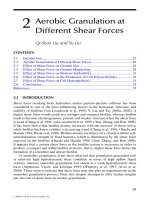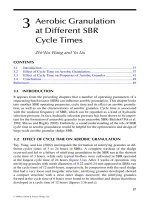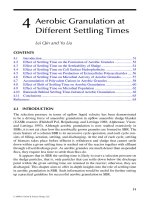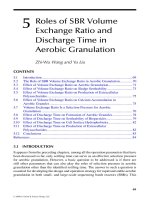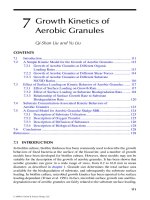Wastewater Purification: Aerobic Granulation in Sequencing Batch Reactors - Chapter 13 potx
Bạn đang xem bản rút gọn của tài liệu. Xem và tải ngay bản đầy đủ của tài liệu tại đây (438.19 KB, 15 trang )
223
13
Calcium Accumulation
in Acetate-Fed
Aerobic Granules
Zhi-Wu Wang, Yong Li, and Yu Liu
CONTENTS
13.1 Introduction 223
13.2 Effect of Calcium on Aerobic Granulation 224
13.3 Calcium Accumulation in Acetate-Fed Aerobic Granules 225
13.4 Chemical form of calcium in acetate-fed aerobic granules 226
13.5 Calcium Distribution in Acetate-Fed Aerobic Granules 227
13.6 Granule Size-Dependent CaCO
3
Formation in Acetate-Fed
Aerobic Granules 227
13.7 Mechanism of Calcium Accumulation in Acetate-Fed
Aerobic Granules 229
13.7.1 Ionic Equilibrium of Carbonate Ion 230
13.7.2 Diffusion Kinetics in Aerobic Granules 231
13.7.3 Distribution of pH and CO
3
2-
in Acetate-Fed
Aerobic Granules 233
13.7.4 Size-Associated Formation of CaCO
3
in Acetate-Fed
Aerobic Granules 234
13.8 Conclusions 235
Symbols 236
References 236
13.1 INTRODUCTION
Ahighcalciumcontenthasbeenreportedinacetate-fedaerobicgranuleseven
though the calcium concentration in the synthetic wastewater was very low (Qin,
Liu, and Tay 2004; Wang, Liu, and Tay 2005). Extensive accumulation of calcium
wasalsofoundinbiolmsandanaerobicgranules(Batstoneetal.2002;Kemner
et al. 2004). Two hypotheses have been put forward to explain the calcium accumu-
lation: (1) calcium links with extracellular polymeric substances (EPS) and forms an
EPS-Ca
2+
-EPScross-linkage;and(2)calciumispresentintheformofCaCO
3
(Yu,
Tay, and Fang 2001; Wloka et al. 2004). This chapter thus explores the mechanism
behind the accumulation, chemical form, and spatial distribution of calcium ion in
acetate-fed aerobic granules.
53671_C013.indd 223 10/29/07 7:34:46 AM
© 2008 by Taylor & Francis Group, LLC
© 2008 by Taylor & Francis Group, LLC
224 Wastewater Purification
13.2 EFFECT OF CALCIUM ON AEROBIC GRANULATION
Ca
2+
has been reported to enhance the formation of anaerobic granules and acido-
genicbiolms(HuangandPinder1995;Yu,Tay,andFang2001).Jiangetal.(2003)
studied the effect of calcium on aerobic granulation in sequencing batch reactors
(SBRs).Forthispurpose,twoSBRswereoperatedattherespectiveCa
2+
concentra-
tionsofzeroand100mgL
–1
.Itwasfoundthataerobicgranuleswereformedinboth
SBRs,andgranulesizeswerestabilizedataround2mmand2.8mminthecalcium-
freeandcalcium-addedSBRs,respectively,after2monthsofoperation(gure13.1).
These results indicate that aerobic granulation may not depend on calcium ion, that
is,calciumionisnotessentialforaerobicgranulationinSBRs.Mahoneyetal.(1987)
investigated anaerobic granulation in two upow anaerobic sludge blanket (UASB)
reactors fed with aero and 100 mg Ca
2+
L
–1
,respectively.Similartotheresultsshown
in gure 13.1, successful anaerobic granulation was achieved in both reactors, indi
-
catingthatcalciumisnotanessentialelementforanaerobicgranulationeither.
Compared to aerobic granules grown on calcium-free medium, aerobic granules
cultivated with addition of calcium showed better settleability
andhigherstrength
(gure 13.1). It is thought that the Ca
2+
ionshouldbindtonegativelychargedgroups
A
B
FIGURE 13.1 Aerobicgranulescultivatedatdifferentcalciumconcentrations,0mg Ca
2+
L
–1
(a) and 100 mg Ca
2+
L
–1
(b).(FromJiang,H.L.etal.2003.Biotechnol Lett 25: 95–99.
With permission.)
53671_C013.indd 224 10/29/07 7:34:48 AM
© 2008 by Taylor & Francis Group, LLC
© 2008 by Taylor & Francis Group, LLC
Calcium Accumulation in Acetate-Fed Aerobic Granules 225
of extracellular polysaccharides present on bacterial surfaces, and act as a bridge to
interconnect these components, so as to promote bacterial aggregation and further
enhance the structural stability of aerobic granules, anaerobic granules, and bio
-
lms (Costerton et al. 1987; van Loosdrecht et al. 1987; Bruus, Nielsen, and Keiding
1992).Itshouldbepointedoutthatsuchaviewisstilldebatable.
13.3 CALCIUM ACCUMULATION IN ACETATE-FED
AEROBIC GRANULES
Wang,Li,andLiu(2007)systematicallyinvestigatedthecalciumaccumulationin
acetate-fedaerobicgranulesharvestedfromacolumnSBRafter2monthsofopera
-
tion, while calcium concentration in inuent was as low as 4.65 mg L
–1
.Itwasfound
that acetate-fed aerobic granules had a high calcium content of 225 mg Ca
2+
mg g
–1
,
contributingto37%ofgranuleashcontent.Comparedtoacetate-fedaerobicgranules,
aerobicgranulesgrownonethanolshowedverylowcalciumandashcontents
(gure 13.2). This seems to suggest that calcium accumulation is a phenomenon
closely associated with the substrate applied.
Ca
2+
(mg g
–1
SS)
0
50
100
150
200
250
Acetate Ethanol
Ash Content (g g
–1
SS)
0.0
0.1
0.2
0.3
FIGURE 13.2 Calcium and ash contents in ethanol- and acetate-fed aerobic granules. (Data
onethanolfromLiu,Yang,andTay2003andonacetatefromWang,Li,andLiu2007.)
53671_C013.indd 225 10/29/07 7:34:49 AM
© 2008 by Taylor & Francis Group, LLC
© 2008 by Taylor & Francis Group, LLC
226 Wastewater Purification
13.4 CHEMICAL FORM OF CALCIUM IN ACETATE-FED
AEROBIC GRANULES
To investigate the chemical form of calcium ion accumulated in acetate-fed aerobic
granules,Wang,Li,andLiu(2007)quantiedtheelementalcomposition(Ca,Mg,P,
Fe, Al) of acetate-fed aerobic granules. The amount of carbonate ion in the acetate-
fedaerobicgranuleswasalsoanalyzed.Forthispurpose,3mlof1Mhydrochloric
acidsolutionwasaddedto50mlof2gsolublesolids(SS)L
–1
acetate-fed aerobic
granules,andthecarbondioxidegasproducedwasonlinemeasuredbythecarbon
dioxidesensorequippedwiththerespirometer(gure13.3).Changesininorganic
carbon in the liquid phase were determined by total organic carbon analyzer before
andaftertheexperiment(Wang,Li,andLiu2007).Thus,thecontentofcarbonatein
acetate-fedaerobicgranuleswascalculatedfromthesumofproducedcarbondioxide
gasandincreasedinorganiccarbonintheliquidphase.Figure13.4showsthemajor
inorganic components of acetate-fed aerobic granules. As can be seen, both Ca
2+
and
CO
3
2-
aredominantovertheotherinorganiccomponents,suchasMg,P,Fe,and
4°C
6
4
5
2
1
3
FIGURE 13.3 Respirometersystemforanalysisofcarbonateintheacetate-fedaerobic
granule:1.computerfordatacollection;2.respirometer;3.fridge;4.shaker;5.acidcontaining
vial;6.reactionbottle.(FromWang,Z W.,Li,Y.,andLiu,Y.2007.Appl Microbiol Biotechnol
74:467–473.Withpermission.)
CO
3
2–
mmol ion g
–1
SS
0.0
0.3
0.6
0.9
1.2
1.5
1.8
Al Mg P Fe Ca
FIGURE 13.4 Ioniccompositionofacetate-fedaerobicgranules.(DatafromWang,Z W.,
Li,Y.,andLiu,Y.2007.Appl Microbiol Biotechnol 74: 467–473.)
53671_C013.indd 226 10/29/07 7:34:50 AM
© 2008 by Taylor & Francis Group, LLC
© 2008 by Taylor & Francis Group, LLC
Calcium Accumulation in Acetate-Fed Aerobic Granules 227
calcium to carbonate was estimated as 1:1.16, indicating that most calcium ions in
aerobicgranulesexistintheformofcalciumcarbonate.Intermsofchemistry,this
also implies that the concentration product of Ca
2+
and CO
3
2-
in acetate-fed aerobic
granules should be larger than the solubility product constant of calcium carbonate.
13.5 CALCIUM DISTRIBUTION IN ACETATE-FED
AEROBIC GRANULES
The calcium distribution in acetate-fed aerobic granules was investigated using a scan-
ning electron microscope (SEM); meanwhile, energy dispersive x-ray spectroscopy
(EDX) was also employed for mapping of calcium distribution (Wang, Li, and Liu
2007). The carbonate localization was determined by chemical titration method, that
is,1Mhydrochloricacidsolutionwasdroppedonaslicedgranulecrosssection,and
theoriginofbubbleswasvisualizedbyimageanalysistechnique(Wang,Li,andLiu
2007).Freshacetate-fedaerobicgranuleswithaspecicoxygenuptakerate(SOUR)
of 64 mg O
2
g
–1
volatile solids (VS) h
–1
;sludgevolumeindex(SVI)of52mLg
–1
,and
oftheaerobicgranule,whilethegranuleshellwasnearlycalciumfree.Theimage
analysis further showed white deposits localized at 300 µm beneath the granule sur
-
(gure 13.5c), gas bubbles were immediately generated (gure 13.5d). The gas phase
analysis conrmed that the bubbles generated were carbon dioxide (gure 13.5d).
These results clearly indicate that both calcium and carbon ions coexist in the same
zoneofacetate-fedaerobicgranules,thatis,calciumexistsmainlyintheformof
CaCO
3
intheacetate-fedaerobicgranules,whichisingoodagreementwiththe
stoichiometric analysis (gure 13.4).
Theaccumulationofcalciumwasobservedinbiolmsandanaerobicgranules,
and Ca
2+
has been often considered to bridge negatively charged sites on extracellular
biopolymers, thus enhancing the matrix stability of attached microbial communi
-
ties (Bruus, Nielsen, and Keiding 1992; Korstgens et al. 2001; Batstone et al. 2002;
Kemneretal.2004;Wlokaetal.2004).Accordingtosuchahypothesis,excessive
calciumhasoftenbeenintroducedintothemediumforenhancedformationofbio
-
lmandanaerobicgranules(HuangandPinder1995;Yu,Tay,andFang2001).
However,itappearsfromgures13.4and13.5thatcalciumdetectedinacetate-fed
aerobic granules was mainly in the form of calcium carbonate rather than in associa
-
tion with extracellular polymeric substances.
13.6 GRANULE SIZE-DEPENDENT CACO
3
FORMATION IN
ACETATE-FED AEROBIC GRANULES
ItshouldbepointedoutthattheaccumulationofcalciumintheformofCaCO
3
in
acetate-fed aerobic granules was found to be granule size-dependent (Wang, Li, and
Liu2007).Ascanbeseeningure13.6,thecalciumcontentofacetate-fedaerobic
granuleswasproportionallyrelatedtothegranulesize,forexample,thecalcium
53671_C013.indd 227 10/29/07 7:34:51 AM
© 2008 by Taylor & Francis Group, LLC
© 2008 by Taylor & Francis Group, LLC
Al,whichareindeedmarginal.Accordingtogure13.4,themolarratioofgranule
ameandiameterof1.4mmwereusedfortheabove-mentionedanalyses (gure13.5).
face(gure13.5c).Afterhydrochloricacidwasaddedtothezoneofwhitedeposits
Figure 13.5a and b clearly show that calcium was mainly accumulated in the core part
228 Wastewater Purification
Sludge Radius Range (mm)
0.1-0.2 0.3-0.4 0.5-0.6 0.7-0.8 0.8-1.0 1.4-2.0
Ca
2+
(mg g
–1
SS)
0
50
100
150
200
250
FIGURE 13.6 Calcium contents in aerobic granules with different radius. (Data from Wang,
Z W.,Li,Y.,andLiu,Y.2007.Appl Microbiol Biotechnol 74: 467– 473.)
(a) (b)
(c) (d)
FIGURE 13.5 (a) Cross-section view of the acetate-fed aerobic granule by SEM; (b) the
EDX mapping for calcium indicated by white color; bar: 100 µm; (c) image analysis cross-
section view of the acetate-fed aerobic granule; (d) generation of gas bubbles during the
acid-granulereaction;scalebar:200µm.(FromWang,Z W.,Li,Y.,andLiu,Y.2007.Appl
Microbiol Biotechnol 74:467–473.Withpermission.)
53671_C013.indd 228 10/29/07 7:34:53 AM
© 2008 by Taylor & Francis Group, LLC
© 2008 by Taylor & Francis Group, LLC
Calcium Accumulation in Acetate-Fed Aerobic Granules 229
contentinbigaerobicgranuleswithradiusof1.4to2.0mmwasnearlytentimes
higherthanthatinsmallaerobicgranuleswithradiusof0.1to0.2mm(gure13.6).
Inthecourseofaerobicgranulation,itwasfoundthattheashcontentwasverylowat
theinitialstageofaerobicgranulation,butitsharplyincreasedontheeighthdayin
responsetoasignicantincreaseingranulesize,andgraduallystabilizedatthelevel
ofabout0.4gg
–1
SSafter40daysofoperation(gure13.7).Thisimpliesthatthecon-
tent of CaCO
3
or so-called ash content was indeed very low in small aerobic granules,
butittendedtoincreasewiththegrowthinsizeofacetate-fedaerobicgranules.
13.7 MECHANISM OF CALCIUM ACCUMULATION IN
ACETATE-FED AEROBIC GRANULES
As discussed earlier, calcium ion is not an essential element necessary for success-
ful aerobic granulation (gure 13.1), and the extensive accumulation of calcium was
Ash Content (g g
–1
SS)
0.00
0.05
0.10
0.15
0.20
0.25
0.30
0.35
Time (days)
0 10203040
Sludge Mean Radius (mm)
0.0
0.3
0.6
0.9
1.2
1.5
FIGURE 13.7 Ashcontentandcorrespondingmeanradiusofacetate-fedaerobicgranules
inthecourseofaerobicgranulation.(DatafromWang,Z W.,Li,Y.,andLiu,Y.2007.Appl
Microbiol Biotechnol 74: 467–473.)
53671_C013.indd 229 10/29/07 7:34:54 AM
© 2008 by Taylor & Francis Group, LLC
© 2008 by Taylor & Francis Group, LLC
230 Wastewater Purification
onlyfoundinaerobicgranulesgrownonacetate(gure13.2).Furthermore,most
accumulated calcium actually existed in the form of CaCO
3
,anditwasmainly
centralizedinthecorepartofacetate-fedaerobicgranules(gures13.4and13.5).
One necessary condition for CaCO
3
formation at the low calcium ion concentration
of 4.65 mg Ca
2+
L
–1
is the presence of high CO
3
2-
concentration at the core of the
acetate-fedaerobicgranulesothattheionicproductofCa
2+
and CO
3
2-
canbehigher
than the solubility product constant of calcium carbonate.
13.7.1 IONIC EQUILIBRIUM OF CARBONATE ION
Intermsofchemistry,theCaCO
3
formationisdeterminedbyitsionicconcentra-
tion product:
[][ ]
,
Ca CO K
sp CaCO
2
3
2
3
(13.1)
where
K
sp CaCO,
3
is the CaCO
3
solubility product constant. Calcium carbonate will
form only when the concentration product of calcium and carbonate is greater than
K
sp CaCO,
3
.Acetatecanbeoxidizedinawaysuchthat:
CH COO O H CO H O
32 22
22
m (13.2)
Dissolutionofcarbondioxidecanbeexpressedasfollows:
CO H O H HCO
22 3
j
(13.3)
and
K
HCO H
CO
a1
3
2
[][]
[]
(13.4)
HCO H CO
33
2
j (13.5)
and
K
CO H
HCO
a2
3
2
3
[][]
[]
(13.6)
The overall reaction for carbonate can be expressed as:
CO H O CO H
22 3
2
2j
(13.7)
It should be pointed out that CO
2
produced in equation 13.2 can be dissolved into
liquid phase according to Henry’s law:
53671_C013.indd 230 10/29/07 7:34:59 AM
© 2008 by Taylor & Francis Group, LLC
© 2008 by Taylor & Francis Group, LLC
Calcium Accumulation in Acetate-Fed Aerobic Granules 231
PKCO
CO h CO
22
2
,
[] (13.8)
where P
CO
2
is the partial pressure of CO
2
in gas phase, [CO
2
] is molar concentration
of CO
2
in the liquid phase, and K
hCO,
2
is the Henry’s constant for CO
2
.
13.7.2 DIFFUSION KINETICS IN AEROBIC GRANULES
Itwasassumedinchapter8that(1)anaerobicgranuleisisotopicinphysical,
chemical, and biological properties; (2) an aerobic granule is ideally spherical; (3)
no anaerobic reaction occurs in the process; (4) aerobic granule responses to the
change of bulk substrate concentration occur so quickly that the response time can
be ignored. As presented in chapter 8, the mass balance equations for a substance
betweenthetwolayersingranulewhoseradiusesare,respectively,randr + dr can
be written as:
D
ds
dr
r
ds
dr
R
ss
2
2
2
¥
§
¦
´
¶
µ
(13.9)
where D
s
and R
s
are, respectively, the diffusion coefcient and mass conversion rate of the
substance.Accordingtoequation13.9,Wang,Li,andLiu(2007)proposedthefollowing
mass diffusion balance equations for O
2
,H
+
,HCO
3
-
,andCO
3
2-
in aerobic granules:
D
dC
dr
r
dC
dr
R
O
OO
O
2
22
2
2
2
2
¥
§
¦
´
¶
µ
(13.10)
D
dC
dr
r
dC
dr
R
H
HH
H
¥
§
¦
´
¶
µ
2
2
2
(13.11)
D
dC
dr
r
dC
dr
R
HCO
HCO HCO
HCO
3
33
3
2
2
2
¥
§
¦
¦
´
¶
µ
µ
(13.12)
D
dC
dr
r
dC
dr
R
CO
CO CO
CO
3
2
3
2
3
2
3
2
2
2
2
¥
§
¦
¦
´
¶
µ
µ
(13.13)
Li and Liu (2005) showed that dissolved oxygen would be a rate-limiting factor
inthegrowthofaerobicgranules,andtheoxygenutilizationratecanbedescribed
by the Monod equation:
R
Y
C
KC
O
x
xO
O
OO
2
2
2
22
R
M
/
max
(13.14)
53671_C013.indd 231 10/29/07 7:35:04 AM
© 2008 by Taylor & Francis Group, LLC
© 2008 by Taylor & Francis Group, LLC
232 Wastewater Purification
in which R
x
is biomass density, Y
xO/
2
is the dissolved oxygen-based growth yield,
K
O
2
is the dissolved oxygen-associated half-rate constant, and µ
max
is the maximum
specic growth rate.
Accordingtoequation13.2,theoxygenutilizationrateandtheH
+
consumption
rateareinterrelatedbyequation13.15,thatis:
RR
O
H consumption
2
2
()
(13.15)
Similarly,thefollowingrelationshipcanbeobtainedfromequations13.3and
13.7 for H
+
,HCO
3
-
,andCO
3
2-
:
RRR
H production HCO CO
()
33
2
2(13.16)
Thus,thenetconsumptionrateofH
+
,namely R
H
in equation 13.11, is given by
equation 13.17:
RR R
H H consumption H production
()()
(13.17)
The dissolved oxygen (DO) concentration at the granule surface can be reason-
ablyassumedtobeequaltoitsbulkconcentrationanditsrateofchangeinthegran-
ulecenterwouldbeclosetozeroinconsiderationoftheDOsymmetricaldistribution
inthegranulecenter(LiandLiu2005),thatis:
CC
O r R bulk O
22
,
(13.18)
dC
dr
O
r
2
0
0
(13.19)
Likewise,
C
H
atthegranulesurfaceisassumedtobeequaltothebulkH
+
con-
centration, and the derivative of C
H
atthecenterofthegranuleiszero(Wang,Li,
and Liu 2007):
CC
H
r R bulk
H
,
(13.20)
dC
dr
H
r
0
0
(13.21)
Equations13.10to13.13weresolvednumericallybyMatlab™7.0basedonthe
nite differentiation principle as described in chapter 8.
53671_C013.indd 232 10/29/07 7:35:11 AM
© 2008 by Taylor & Francis Group, LLC
© 2008 by Taylor & Francis Group, LLC
Calcium Accumulation in Acetate-Fed Aerobic Granules 233
13.7.3 DISTRIBUTION OF PH AND CO
3
2-
IN ACETATE-FED AEROBIC GRANULES
According to the models presented above, the pH and CO
3
2-
proles in aerobic gran-
ules were simulated along the granule radius (gure 13.8). For an aerobic granule
witharadiusof0.7mm,thepHandCO
3
2-
proles can be divided into two regimens,
thatis,withinadepthof300µmfromthegranulesurface,asignicantdeclinein
bothpHandcarbonateconcentrationswasfound,whereasfromthedepthof300µm
tothecenterofthegranule,theconcentrationsofpHandcarbonateremainnearly
constantatthemaximumlevels.Infact,asimilarpHprolewasalsoobservedinthe
acetate-fed anaerobic granule (de Beer et al. 1992). The maximum calcium concen
-
trationinagranuleisequaltoitsbulkconcentration,thatis,about1.16
t 10
–4
mol
Ca
2+
L
–1
, thus according to equation 13.1, the required minimum CO
3
2-
concentration
fortheformationofCaCO
3
was estimated as 2.9 t 10
–5
2.9 t 10
–5
mol L
–1
.Inviewof
the CO
3
2-
prole in gure 13.8, it is reasonable to consider that CaCO
3
will be formed
mainly in the region with a depth below 300 µm from the granule surface, that is,
r <
R
CaCO
3
zone in gure 13.8. Such a theoretical prediction is in good agreement
pH
8.50
8.51
8.52
8.53
8.54
8.55
8.56
r(mm)
0.0 0.2 0.4 0.6
CO
3
2–
(M)
2.4e-5
2.5e-5
2.6e-5
2.7e-5
2.8e-5
2.9e-5
R
CaCO
3
FIGURE 13.8 Simulated proles of pH and CO
3
2-
in acetate-fed aerobic granules. (Data
fromWang,Z W.,Li,Y.,andLiu,Y.2007.Appl Microbiol Biotechnol 74: 467–473.)
53671_C013.indd 233 10/29/07 7:35:13 AM
© 2008 by Taylor & Francis Group, LLC
© 2008 by Taylor & Francis Group, LLC
234 Wastewater Purification
with the experimental observation, as shown in gure 13.5. It can be concluded from
gure13.8thatthecalciumaccumulationinacetate-fedaerobicgranulesismainly
duetothefactthatalkalinityintheformofhydroxideionwasproducedduringthe
biological oxidation of acetate, as illustrated in equation 13.2. In contrast, no hydrox
-
ide ion actually can be generated in the biological oxidation of ethanol. This explains
whycalciumisnotaccumulatedintheethanol-fedaerobicgranulesbutonlyinthose
fedwithacetate(gure13.2).
13.7.4 SIZE-ASSOCIATED FORMATION OF CACO
3
IN
A
CETATE-FED AEROBIC GRANULES
The volume fraction of the CaCO
3
formable region in acetate-fed aerobic granules,
namely
()RR
CaCO
3
3
,wassimulatedatvariousgranuleradiusesintherangeof0to
2mm(gure13.9).Itappearsthattheformationofcalciumcarbonateisnegligible
inaerobicgranulessmallerthan0.5mminradius,andcalciumcarbonatestarts
toformonlyinaerobicgranuleslargerthan0.5mminradius.Thisinturnpro
-
vides a plausible explanation for the observed size-dependent CaCO
3
formation in
aerobicgranules(gures13.6and13.7).Suchtheoreticalestimationisprettycon-
sistentwiththeexperimentalresultsmeasuredasthecalciumandashcontentsin
aerobicgranules(gure13.9).Batstone
et al. (2002) has put forward a hypothesis
thatpreformationofacrystalCaCO
3
coreisaprerequisiteofanaerobicgranulation.
However, both experimental and theoretical evidence in gures 13.6, 13.7, and 13.9
point to the fact that calcium accumulation occurs only after aerobic granulation,
and a crystal CaCO
3
core is indeed not required for aerobic granulation. In fact,
increasing evidence shows that microbial granulation is a cell-to-cell self-immobili
-
zation process driven mainly by selection pressures (see chapter 6), that is, calcium
mayplayaveryminorroleinthemicrobialgranulationprocess,andaerobicaswell
as anaerobic granulation is indeed calcium independent (Mahoney et al. 1987; Jiang
etal.2003).Thispointisalsosupportedbymanyotherpreviousstudiesonaerobic
andanaerobicgranulation(Guiotetal.1988;Thieleetal.1990;El-Mamounietal.
1995;VanLangeraketal.1998;Jiangetal.2003).
It appears from microscopic observation and chemical analysis that the accu
-
mulation of calcium is in the form of CaCO
3
,andthoseaccumulationswere
centralized in the core part of acetate-fed aerobic granules (gures 13.4 and 13.5).
The fact that CaCO
3
is only formed in aerobic granules with a radius larger than
0.5 mm (gures 13.6 and 13.7) indicates that the formation of calcium carbonate in
the acetate-fed aerobic granules is actually granule size dependent, which can be
explained by the diffusion limitation described by equations 13.10 to 13.13. This is
becausethemicrobialmetabolites,suchasalkalinityandcarbondioxideproduced
by acetate oxidation, can react with each other to produce carbonate, and form an
ionicequilibrium,asillustratedinequations13.2,13.3,and13.5.Astheresultof
mass diffusion described in equation 13.3, a carbonate gradient along the granule
radius is established towards the bulk solution so as to diffuse the carbonate out
of the granule. This means that the highest carbonate concentration is found inside
theaerobicgranule(gure13.8).Itshouldberealizedthatthiscarbonategradient
53671_C013.indd 234 10/29/07 7:35:14 AM
© 2008 by Taylor & Francis Group, LLC
© 2008 by Taylor & Francis Group, LLC
Calcium Accumulation in Acetate-Fed Aerobic Granules 235
increaseswiththesizeoftheaerobicgranule.Thereby,alargeaerobicgranulewould
haveahighcarbonateconcentrationinitscentralpart,asshowningure13.9.
13.8 CONCLUSIONS
Calciumisindeednotanessentialelementrequiredforsuccessfulaerobicgranu-
lation. The excessive calcium accumulation phenomenon appears to be substrate
dependent, and it only happens to the acetate-fed aerobic granules. Unlike specu
-
lation by some researchers, most calcium excessively accumulated in acetate-fed
aerobicgranulesactuallyexistsintheformofCaCO
3
deposit rather than binding
with extracellular polysaccharides. It is actually the acetate biological oxidation-
associated carbonate ionic equilibrium as well as the mass diffusion limitation that
result in the high carbonate concentration centralized in the center of an aerobic
granule, and further lead to CaCO
3
formation in the granule core part. The volume
0.0
0.1
0.2
0.3
0.4
0.5
Ca
2+
(mg g
–1
SS)
50
100
150
200
250
R(mm)
0.0 0.5 1.0 1.5 2.0
(R
CaCO
3
/R)
3
(R
CaCO
3
/R)
3
0.0
0.1
0.2
0.3
0.4
Ash Content (g g
–1
SS)
0.0
0.1
0.2
0.3
0.4
0.5
0.6
FIGURE 13.9 Comparisons of the simulated and experimentally measured CaCO
3
as well
as ash contents in the acetate-fed aerobic granules. —:
()RR
CaCO
3
3
simulation; D:calcium
content; $:ashcontent.(DatafromWang,Z W.,Li,Y.,andLiu,Y.2007.Appl Microbiol
Biotechnol 74: 467–473.)
53671_C013.indd 235 10/29/07 7:35:18 AM
© 2008 by Taylor & Francis Group, LLC
© 2008 by Taylor & Francis Group, LLC
236 Wastewater Purification
fraction of this CaCO
3
formedspaceinthegranuletendstoexpandwiththegranule
size increase, as a result of the correspondingly upgraded extent of mass diffusion
limitation. CaCO
3
isnotlikelytoformingranulessmallerthan0.5mminradius,
providing experimental and theoretical evidence that a crystal CaCO
3
core is not
required for granulation.
SYMBOLS
D
s
Acetate diffusion coefcient
D
fo
Oxygen diffusion coefcient
μ(s) Growth rate at substrate concentration s
μ
max
Maximum growth rate
K
s
Half rate constant
Y
x/o
Growth yield of oxygen
Y
x/s
Growthyieldofsubstrate
S
bulk
Bulk substrate concentration
S
x
Biomass density
R The radius of a granule
r One-dimensional coordinate
∆r The thickness of one layer
R
Average radius of all granules
s
i
Substrate concentration at the ith layer
s Substrate concentration at a point of a granule
∆S
bulk
The change of bulk substrate concentration
S
bulk 0
Initial bulk substrate concentration
v Substrate conversion rate
v
1
Substrate conversion rate of a granule
V Volume of the reactor
v
all
Substrate conversion rate of all granules
X Biomass concentration
m Numberofaerobicgranulesinareactor
REFERENCES
Batstone, D. J., Landelli, J., Saunders, A., Webb, R. I., Blackall, L. L., and Keller, J. 2002.
The inuence of calcium on granular sludge in a full-scale UASB treating paper mill
wastewater.
Water Sci Technol 45: 187–193.
Bruus,J.H.,Nielsen,P.H.,andKeiding,K.1992.Onthestabilityofactivatedsludgeocs
with implications for dewatering.
Water Res 26: 1597–1604.
Costerton,J.W.,Cheng,K.J.,Geesey,G.G.,Ladd,T.I.,Nickel,J.C.,Dasgupta,M.,and
Marrie,T.J.1987.Bacterialbiolminnatureanddisease.
Annu Rev Microbiol
41: 435– 464.
de Beer, D., Huisman, J. W., Van den Heuvel, J. C., and Ottengraf, S. P. P. 1992. Effect of pH
proles in methanogenic aggregates on the kinetics of acetate conversion.
Water Res
26: 1329–1336.
53671_C013.indd 236 10/29/07 7:35:19 AM
© 2008 by Taylor & Francis Group, LLC
© 2008 by Taylor & Francis Group, LLC
Calcium Accumulation in Acetate-Fed Aerobic Granules 237
El-Mamouni, R., Guiot, S. R., Mercier, P., and Sa, B. 1995. Liming impact on granules
activityofthemultiplateanaerobicreactor(MPAR)treatingwheypermeate.Bioprocess
Eng 12: 47.
Guiot,S.R.,Gorur,S.S.,Bourque,D.,andSamson,R.1988.Metaleffectonmicrobial
aggregation during upow anaerobic sludge bed-lter (UBF) reactor start-up. In
Granular anaerobic sludge, microbiology and technology. 187–194.
Lettinga, G.,
Zehnder,A.J.B.,Grotenhuis,J.T.C.,andHulshoffPol,L.W.eds.Wageningen,the
Netherlands: Purdoc.
Huang, J. and Pinder, K. L. 1995. Effects of calcium on development of anaerobic acidogenic
biolms.
Biotechnol Bioeng 45: 212–218.
Jiang,H.L.,Tay,J.H.,Liu,Y.,andTay,S.T.L.2003.Ca2+augmentationforenhancement
of aerobically grown microbial granules in sludge blanket reactors.
Biotechnol Lett
25: 95–99.
Kemner, K. M., Kelly, S. D., Lai, B., Maser, J., O’Loughlin, E. J., Sholto-Douglas, D.,
Cai,Z.H.,Schneegurt,M.A.,Kulpa,C.F.,andNealson,K.H.2004.Elemental
and redox analysis of single bacterial cells by X-ray microbeam analysis.
Science
306: 686–687.
Korstgens, V., Flemming, H. C., Wingender, J., and Borchard, W. 2001. Inuence of calcium
ionsonthemechanicalpropertiesofamodelbiolmofmucoidPseudomonasaerugi
-
nosa.
Water Sci Technol 43: 49–57.
Li,Y.andLiu,Y.2005.Diffusionofsubstrateandoxygeninaerobicgranule.Biochem Eng J
27: 45–52.
Liu,Y.,Yang,S.F.,andTay,J.H.2003.Elementalcompositionsandcharacteristicsof
aerobic granules cultivated at different substrate N/C ratios. Appl Microbiol Biotechnol
61: 556–561.
Mahoney,E.M.,Varangu,L.K.,Cairns,W.L.,Kosaric,N.,andMurray,R.G.E.1987.The
effect of calcium on microbial aggregation during UASB reactor start-up.
Water Sci
Technol 19: 249–260.
Qin,L.,Liu,Y.,andTay,J.H.2004.Effectofsettlingtimeonaerobicgranulationina
sequencing batch reactor.
Biochem Eng J 21: 47–52.
Thiele,J.H.,Wu,W.M.,Jain,M.K.,andZeikus,J.G.1990.Ecoengineeringhighrate
anaerobic digestion systems. Analysis of improved syntrophic biomethanation cata
-
lysts.
Biotechnol Bioeng 35: 990–999.
VanLangerak,E.P.A.,Gonzalez-Gil,G.,VanAelst,A.,VanLier,J.B.,Hamelers,H.V.M.,
andLettinga,G.1998.Effectsofhighcalciumconcentrationsonthedevelopmentof
methanogenic sludge in upow anaerobic sludge bed (UASB) reactors.
Water Res 32:
1255–1263.
vanLoosdrecht,M.C.,Lyklema,J.,Norde,W.,Schraa,G.,andZehnder,A.J.1987.Electro-
phoretic mobility and hydrophobicity as a measure to predict the initial steps of bacterial
adhesion.
Appl Environ Microbiol 53: 1898–1901.
Wang, Z W., Li, Y., and Liu, Y. 2007. Mechanism of calcium accumulation in acetate-fed
aerobic granules.
Appl Microbiol Biotechnol 74: 467–473.
Wang,Z W.,Liu,Y.,andTay,J.H.2005.TheroleofSBRmixedliquorvolumeexchange
ratio in aerobic granulation.
Chemosphere 62: 767–771.
Wloka,M.,Rehage,H.,Flemming,H.C.,andWingender,J.2004.Rheologicalpropertiesof
viscoelastic biolm extracellular polymeric substances and comparison to the behavior
of calcium alginate gels.
Colloid Polym Sci 282: 1067–1076.
Yu,H.Q.,Tay,J.H.,andFang,H.H.P.2001.Therolesofcalciuminsludgegranulation
during UASB reactor start-up. Water Res 35: 1052–1060.
53671_C013.indd 237 10/29/07 7:35:19 AM
© 2008 by Taylor & Francis Group, LLC
© 2008 by Taylor & Francis Group, LLC


